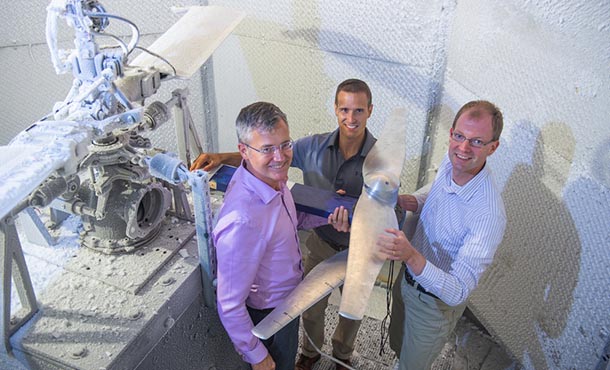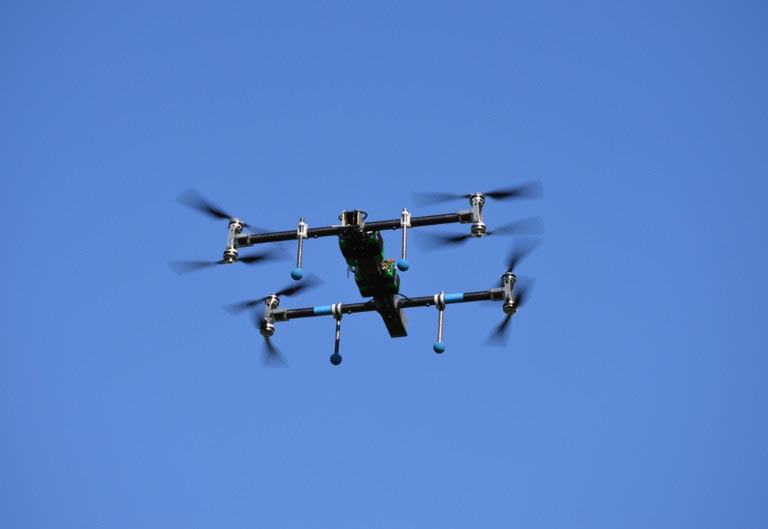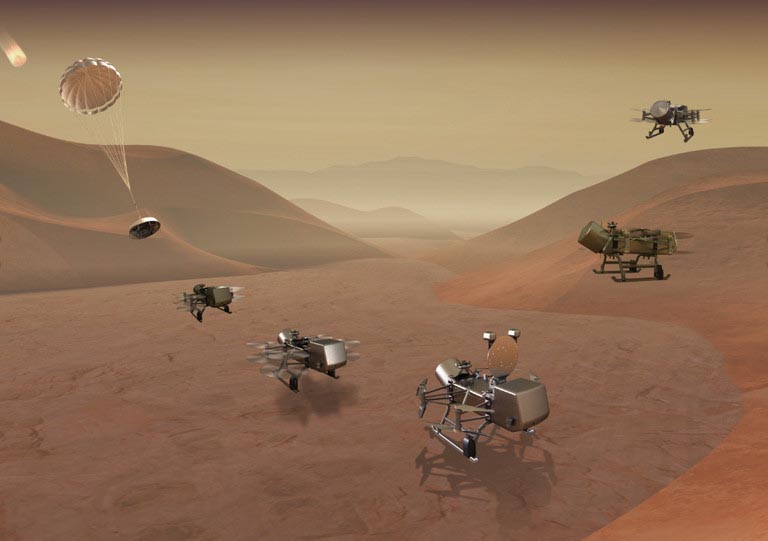
Jack Langelaan, Jose Palacios and Sven Schmitz, all associate professors in aerospace engineering at Penn State, are posed with the rotor and blade they are testing in a chamber that can reach –145° Celsius, only about 50 degrees warmer than the surface of Saturn’s largest moon. IMAGE: TYLER HENDERSON/PENN STATE
Lasting work: Penn State engineers help NASA go to Titan for mission 'Dragonfly'
9/24/2019
By Ashley WennersHerron
UNIVERSITY PARK, Pa. — Jack Langelaan, an associate professor of aerospace engineering at Penn State, was uncharacteristically animated. He leaned forward, his hands punctuating his words as he described the great achievements of humanity.
“The Egyptians built the pyramids; medieval Europeans built the cathedrals,” he said, taking a breath and leaning back in his chair. He gestured to his colleagues sitting on either side of him. “And our society builds space vehicles.”
Sven Schmitz and Jose Palacios, both associate professors of aerospace engineering at Penn State, nodded in agreement. All three grinned.
“Something we build is going to Titan! This is the dream!” Palacios exclaimed. His excitement bubbled over, and the grins turned to laughter.
These three engineers are leading the Penn State team on an $850 million NASA mission spanning at least the next two decades. The Johns Hopkins University Applied Physics Laboratory (APL) leads the endeavor — dubbed “Dragonfly” — to investigate surface and atmospheric conditions of Saturn’s largest moon, which in many ways appear to be strikingly similar to Earth’s primordial state.
In June, NASA announced that Dragonfly would be the fourth mission under its competitive New Frontiers program, which funds projects that shed light on scientific mysteries of the solar system. Dragonfly is scheduled to launch in 2026 and reach the surface of Titan around New Year’s Eve in 2034.
For engineers who built their careers by understanding how vehicles fly on Earth, the opportunity to develop a vehicle that will explore Titan is almost unbelievable.
The phone call
Penn State is home to one of three national Vertical Lift Research Centers of Excellence designated by the United States Army, Navy and NASA. A collaborative effort between academia and government, the centers provide resources to advance vertical lift research while also training the next generation of flight engineers. Georgia Tech and the University of Maryland in College Park house the other two centers. Langelaan, Palacios and Schmitz are all affiliated with the center, where they specifically focus on helicopter design and advancement.
“Three years ago, APL called us for help on this project,” Langelaan said. “They wanted to go to space, and they needed helicopter people.”
The team at APL envisioned something more than the traditional land rovers that roam Earth’s Moon and Mars. A flying probe couldn’t capture the samples and conduct the science they wanted. They needed a drone.
Zibi Turtle, the Dragonfly principal investigator at APL, said that Dragonfly was designed to be a rotorcraft to explore Titan because “it’s the best way to travel and be able to make science measurements in multiple locations in Titan’s environment.”
Titan is a world with a deep liquid water ocean in its interior and an Earth-like surface with sand dunes, lakes and seas on the surface. But at Titan’s surface temperature of –180° C, the sand is organic, and the lakes and seas are filled with liquid methane — methane even forms clouds and rain. With conditions that may replicate aspects of Earth’s chemistry before life developed, Titan could offer a unique glimpse into how chemistry becomes biology, according to Turtle.
“They needed a drone that could land, collect samples, run experiments and fly again,” Schmitz said. “Those requirements pose unique design problems in Earth’s atmosphere. On Titan, where it’s minus 180 C, things can get more complicated. We were interested.”
“Getting that call from APL was fun,” Langelaan said. “And then we did a lot of work during our own time and using our own research development funds.”
Nuts and bolts and blades
NASA’s highly selective New Frontiers Program doesn’t offer any funding during the early phases of the competition.
“We are lucky to work in a department at a university where curiosity and individual pursuits are valued,” Schmitz said.
Palacios added: “And where our industrial pursuits are supported. We can actually cut metal to test theories here. Other universities might not have been happy providing so many resources up front in pursuit of a project that wasn’t guaranteed to be funded.”
The College of Engineering’s Department of Aerospace Engineering internally funded the team’s preliminary work in part. Langelaan, Palacios and Schmitz also kicked in money from their discretionary funds to buy the parts needed for their first prototype vehicle.
“As with all exploratory research, what you think you’re developing could lead to very different, unintended applications,” Langelaan said. “There’s also a lot of work that needs to be done to figure out what work is necessary. The good thing about research is that even when things don’t turn out as expected, we learn something.”
In January 2018, Dragonfly and a Cornell University-led project called the Comet Astrobiology Exploration Sample Return (CAESAR) were selected as the two finalists. At that point, NASA provided a year of funding for both projects.
“That was nice,” Palacios said. “We’re in the aerospace engineering department, but we’re all focused on the aero part. To have NASA funding for a potential space mission? The project turned from something that was interesting to something that could be real. That was exciting.”
The Penn State team, responsible for the aerodynamics and rotorcraft design portions of the drone, used some of the funds to develop a 45% scale prototype. It’s reminiscent of an actual dragonfly, with a dark, spiny body and four wings. Each wing is stationary, holding stacked rotor blades. All eight rotors need to move independently in extremely cold conditions.
With the co-axial quadcopter design, the team is building in flight redundancy. Even if one rotor fails, the machine can still fly with a high level of control.
Now that NASA has selected Dragonfly as the next New Frontiers mission, the team is figuring out exactly how to make the blades move for efficient flight. On a normal helicopter, the blades can adjust their angle for more control during take-off, hovering or climbing in altitude. Such movements aren’t possible on Titan.
“That’s the trick,” Schmitz said. “We can’t change the blade angle at all, only the speed they rotate. We have to find one angle for every situation: maneuver, hover, forward flight. One angle to rule them all!”
The real thing
The actual Dragonfly drone will be a little larger than the slim prototype.
“It’s about the size of a bug,” Palacios said. Schmitz and Langelaan looked at him.
“A Volkswagen Beetle,” Schmitz clarified.
Palacios laughed, realizing the confusion, “Oh, yeah. A bug that weighs almost a ton!”
“But it’s taller,” Langelaan added.
“It’s bulkier because it has to do a lot more,” Palacios said. “It has to carry the equipment to conduct science, but it also has to be sleek because it has to fly. It’s not a rover that rolls along at half a mile an hour. It can’t have antennae sticking out.”
This challenge exemplifies the difficulty and beauty of the relationship with the researchers at APL, according to the team. The engineers want to build the best flying machine, while the scientists need to investigate the organic chemistry of Titan’s surface.
“There’s a lot of back and forth to make sure we’re accounting for their science while also making sure the thing can fly,” Langelaan said. “We’re learning a lot from each other. It pushes us to be more innovative in our design.”
The ability to fly is also expanding the kind of research the scientists can conduct. The drone can cover the distance in one flight that a land rover might not achieve in its lifetime, according to Schmitz.
The flight might be the easiest aspect of the design of the drone. Titan’s conditions are ideal for flight, with a seventh of Earth’s gravity and a denser atmosphere.
“I could stand on Titan and flap my arms really hard, and I’d fly,” Palacios said.
The main issue is the temperature. Titan’s surface is about 180° C below the freezing point of water. Helicopters on Earth use a significant amount of lubricant to keep the motor bearings loose and moveable so that the blades can move without friction. On Titan, that same lubricant would freeze and prevent movement.
In Palacios’ laboratory, he has an octogen-shaped chamber the size of a small bedroom with walls covered in steel. In the middle is a large rotor, capped by a shiny blade about four feet in diameter. A matching blade is held under the rotor. He can pump the chamber full of liquid nitrogen, dropping the temperature down to about –145° C (only 50 degrees warmer than Titan’s surface), and turn on the rotor to see how it behaves.
“We’re lucky we can almost match the conditions on Titan for testing,” Palacios said.
Beyond designing a rotor system and deciding on blade angles, the team is also responsible for helping to develop the flight control systems. Langelaan said this is one of the most difficult aspects, since GPS can’t be used for navigation, and Titan is too far away from the sun to be solar powered. Instead, it’s being designed to use a Multi-Mission Radioisotope Thermoelectric Generator system — the same power source used by Curiosity on Mars — to charge its systems. Each charge could power about 13 miles of flights.
“Dragonfly will charge at night and fly in the morning,” Langelaan said, explaining that one Titan day is equivalent to about 16 days on Earth. “That means for each flight day, the scientists will have about two weeks to analyze the samples and data collected, which will inform where Dragonfly next flies.”
During the two-and-a-half years of Dragonfly’s planned mission, it will fly for a total of about 40 hours.
The charging system requires a sophisticated control system to allocate power appropriately. This system is also significantly important for the navigation.
“Dragonfly needs to be as close to autonomous as possible,” Langelaan said. “It needs to be able to assess information about where it’s landing and follow directions from Earth about where to go next. Dragonfly will have to make decisions, and we need to provide the tools for it to do that.”
Before Dragonfly explores Titan, though, it has to get there first.
“That initial maneuver is critical,” Langelaan said. “Dragonfly will be contained in a spacecraft for the eight years it takes to reach Titan’s atmosphere. When the rotors first spin, they have to work. They have to work even if they’re damaged during the trip or upon entry.”
Held in a heat-resistant capsule, Dragonfly will enter Titan’s atmosphere with the help of two parachutes. At the 110-minute mark, the main parachute will drop away. At that point, Dragonfly must fly on its own.
“It can take a radio signal up to three hours to travel from Earth to Titan and back again,” Langelaan said. “Dragonfly has to fly completely autonomously — we can’t help it from Earth.”
Not only must Dragonfly fly independently, it must also find a suitable landing spot without human assistance.
“Right now, the schedule has Dragonfly reaching Titan around New Year’s Eve of 2034,” Palacios said. “That sounds like it’s far away; like we have a lot of time, but we have a lot to accomplish before that point.”
Counting down
“How do we get to New Year’s Eve?” Schmitz said. “The students. We couldn’t do any of this without the students.”
As an academic partner on Dragonfly, Penn State receives some NASA funding to financially support students working on the project.
“Students will earn their doctoral degrees with the work they do on Dragonfly,” Langelaan said.
According to Langelaan, the researchers plan to recruit additional undergraduate and graduate students to contribute to Dragonfly, although the students already in their labs were incredulous when the project was selected by NASA.
“They couldn’t believe it. As a student, they get to contribute to something that will have huge scientific implications far into the future — for humanity, not just their own scientific careers,” Langelaan said.
Palacios credits the students with significant contributions.
“They’re in it 24 hours-a-day, seven days-a-week,” he said. “Faculty members, we have a lot of other responsibilities and multiple projects. The students are the ones who work through the small technical problems and develop solutions that add up in a big way.”
The future
The Penn State team’s goal is to help develop a rotorcraft drone that can carry the necessary scientific equipment while flying and landing multiple times on Titan. The researchers, with the support of Penn State’s Department of Aerospace Engineering, will also begin teaching helicopter-rotor design graduate courses this fall focused on applying vertical-flight concepts to space vehicles. They expect this to attract the top students.
“We’re developing this tool that could ultimately provide solutions for Earth with information gathered a billion miles from home,” Langelaan said. “That’s as cool as it gets.”
During this development, engineering faculty and students will solve innumerable problems. They will make discoveries and improve the materials and controls of flight vehicles — just as ancient Egyptians and medieval Europeans advanced building methods and invented architectural marvels.
“The pyramids lasted; the cathedrals lasted,” Langelaan said. “Dragonfly? That’s work that will last.”



